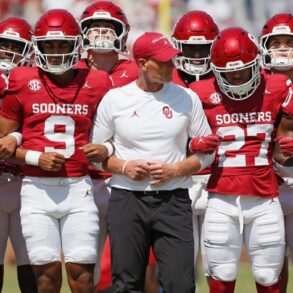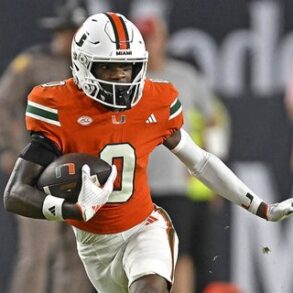The lengthy 2024 season has been over for more than a month, the transfer portal has settled down for now, and we’re waiting to find out if the sport’s powers-that-be are going to change the format of the College Football Playoff for 2025 and beyond.
It seems like as good a time as any to start talking about who might actually be good in 2025!
Early each offseason, I spit out initial SP+ projections, based on a forever-changing combination of returning production, recruiting and recent history. As always, those projections stem from three primary questions: How good has your team been recently? How well has it recruited? And who returns from last year’s roster?
SP+ projections are still a few days away, but let’s deal with that last question first. Who returns a majority of last year’s production? Who has done the best job of importing production from another team? Who is starting from scratch?
For a few years now, I’ve been attempting to expand how we measure returning production. The formula I created shifts with each new year of data and has had to shift a ton with the rising number of transfers. But the gist remains the same: High or low returning production percentages correlate well with improvement or regression. They might not guarantee a good or bad team, but they can tell us a lot. And in 2025, they tell us a lot about the state of college football.
Looking through the prism of returning production data of every FBS team, we’ll break down how the percentage of returning players is trending, what the numbers mean for your favorite team and which teams can expect to improve and which could regress in 2025.
Jump to a section:br/>Percentages | Transfersbr/>Returning trends| What numbers meanbr/>Likely to improve | Likely to regress

Returning production percentages
Here are the returning production percentages and rankings for all 136 FBS teams for 2025. (Yes, we’re up to 136. Hello,Delawareand Missouri State!)
How SP+ accounts for transfers
With the explosion in use of the transfer portal in recent years, I’ve had to significantly change the way transfers are accounted for in the SP+ projections. They show up in both the returning production piece here and in the recruiting portions referenced above.
For returning production, I mash an incoming player’s production from his previous team into the numerator and denominator for his new team. (Because the translation in moving from the lower levels of the sport to the FBS is extremely inconsistent, I give only half-credit for players transferring up from lower divisions.) So if your quarterback leaves, and you bring in a transfer who was productive elsewhere — hello, Miami(Carson Beck) and Indiana(Fernando Mendoza) — that dampens the blow of your QB leaving.
For the recruiting aspect, I attempt to account for incoming transfers’ recruiting rankings in a given team’s overall recruiting averages. The initial impact of a given recruiting class (freshmen plus transfers) is skewed heavily toward transfers before shifting toward younger recruits in future seasons.
Here is the current weighting for determining the offensive percentages above:
Percent of returning OL snaps: 40% of the overall number
Percent of returning WR/TE receiving yards: 35%
Percent of returning QB passing yards: 22%
Percent of returning RB rushing yards: 3%
Broken out by position/player, you’re looking at roughly 22% for the quarterback, 9% for each of four wide receivers and/or tight ends, 8% for each offensive lineman and 3% for the running back. Keep in mind: This is not based on my personal opinion of positional importance — it’s all about what impacts the numbers the most. On average, teams are able to overcome turnover at running back more easily than turnover at other positions. That’s how Arizona Stateand Boise Statecan both end up in the top 10 in returning production despite losing two running backs — Cam Skattebo and Ashton Jeanty, respectively — who combined for 4,312 rushing yards in 2024.
Breaking things out by position is a bit trickier on defense, where units aren’t as strictly defined and the percentage of returning production is derived both from position units and types of stats. I’ve also finally begun incorporating raw snap counts into the defensive production averages, and it seems to be a pretty strong predictor. Here’s the approximate layout:
Percent of returning snaps: 66%
Percent of returning tackles: 19%
Percent of returning tackles for loss: 15%
By position, linebackers make up about 35% of the defensive formula, while the defensive line is at 33% and the defensive backs are at 32%.
(Note: Because Delaware and Missouri State played at the FCS level in 2024, I didn’t have full snap-count data for them. I used an estimated number of O-line snaps based on each player’s number of starts and game participation, and I used an estimated number of defensive snaps based on each player’s tackle totals.)
Returning production is lower than ever in 2025
I have been collecting returning production data since 2014, but between the rapid increase in transfers and the bonus eligibility year associated with the 2020 COVID season, the situation has consistently changed of late. So have the returning production averages. Since 2021, when returning production totals peaked due to the immediate effects of the bonus eligibility year, the national averages have sunk by 23 percentage points, starting with a significant drop in 2022 and, interestingly, another solid decline this offseason.
We have another transfer window to come, so these averages aren’t set in stone. But the national average shifted only from 58.7% last February to 59.9% in August; it’s all but certain that we will end up with all-time lows in the returning production department this season.
I think there are two primary causes for this. First, most of the players with remaining years of bonus eligibility due to 2020 have officially cycled out of the system. Granted, if you were a true freshman in 2020, received the bonus year, then redshirted in 2021, you’ll still be a redshirt senior in 2025. But a healthy portion of the remaining bonus players are gone.
Second, use of the transfer portal is only speeding up. In 2023, FBS teams averaged 10.7 incoming transfers. In 2024, that rose to 13.9, and we’re already at 14.1 in 2025. Sure, a lot of the production from these transfers has just shifted from one school to another. But because of the way I calculate the numbers, a transfer is still a net negative.
Here’s an overly simple example: Team A loses its starting quarterback and therefore returns 0% of its passing production, while Team B returns its starting quarterback and is at 100%. Between the two, that’s a 50% average. But if Team A pulls in Team B’s QB via the portal, it boasts around 50% returning passing production, while Team B is at 0%. Between the two, they’re averaging around 25%. So an increase in transfers drags down the national average.
There’s also a clear drag on teams in the Group of 5, which are losing stars to higher-level schools and conferences at an increasing rate. As cool as it was that Jeanty stayed at Boise State and led his team to its first CFP bid, it was the exception, not the rule.
In all, power conference teams are averaging 58.6% returning production, while the Group of 5 is at a ghastly 49.0%.

The challenges are mounting for G5 programs, and this should ring alarm bells for those, like me, who enjoy the big-tent aspect this sport has embraced through the years. There is nothing more fun than when “College GameDay” visitsAppalachian Stateor Boise State or some other mid-major program that is knocking off the big boys. But we’re increasingly tilting the field against those stories, and we either care enough to do something about that or we don’t. I wish it were the former, but evidence certainly points to the latter.
Long story short: We’ve got less continuity than ever in 2025. This is especially noticeable at running back (in 2023, the national average for returning RB snaps was 63.7%, but it’s now down to 53.0%), wide receiver/tight end (down from 60.0% in 2023 to 51.6%) and, especially, defensive line (down from 64.3% to 51.4%).
What these numbers mean for your team
Over the past three years, we’ve seen 23 of 398 total FBS teams (5.8%) returning at least 78% of their production in a given season. For a 136-team FBS, that’s equivalent to about 7.9 teams per year. But right now only two teams clear that bar: Clemsonand Arizona State.
If we lower the bar all the way to 70%, that ropes in six more teams for 2025: Illinois, Kennesaw State, Rutgers, Texas A&M, Texas Techand Vanderbilt. Over the past three years, teams at 70% returning production or higher have improved 70% of the time, which says good things for five or six of the eight teams above. Those that improved did so by an average of 7.1 points, and considering Clemson and ASU made the CFP in 2024 and Illinois and Texas A&M both ranked 31st or better in SP+, a touchdown’s worth of improvement from any of these teams would be significant for their playoff hopes.
Now let’s flip to the other end of the spectrum. From 2022 to 2024, 15% of teams returned less than 50% of production, equivalent to about 21 teams from a 136-team FBS. But right now, 46 teams are under 50%. If we look solely at the teams returning less than 40% — there are 19 in 2025, 18 at the G5 level — regression comes for 75% of those on average, and 50% fall by at least 10 points in SP+.
We’ll see if that remains the case this season with so many teams dealing with such turnover, but among the 19 teams under 40% are five that ranked 70th or better in SP+ last season: Memphis(32nd in SP+ in 2024), UNLV(36th), Marshall(59th), Washington State(68th) and Miami (Ohio) (69th). Consider this a red flag for those teams.
There are no guarantees here, of course. Returning 87% of its production didn’t keep BYUfrom underachieving in 2022 and returning 33% didn’t prevent Louisiana-Monroe from improving in 2024. And the transfer train brought improvement for teams such asColoradoand Texas Statein 2023 even with minimal returning production. Still, there’s usually reason for pessimism for the teams at the very bottom of this list. (See: Air Forcein 2024. The Falcons plummeted as expected after terribly low returning production.) The five teams under 30% — Jacksonville State, Nevada, New Mexico, Northern Illinoisand Washington State — might not enjoy 2025 all that much.
Most likely to improve in 2025
Again, the percentages above correlate to improvement and regression, not pure quality. That’s important to reinforce. But plenty of this year’s top teams from a returning production standpoint were also pretty good last year. Now they’ve got a chance to get even better.
Here are the nine teams that (A) ranked in the SP+ top 40 in 2024 and (B) currently rank in the top 25 in returning production:
Most likely to regress in 2025
The best teams in the country in a given season tend to lose quite a bit of their production to the NFL in a given offseason, but it might be noteworthy that five of last year’s top seven teams, per SP+, rank 101st or worse in returning production. They’re all at 46% or lower. Considering the number of teams that were ranked in last year’s teens and 20s and look to be more experienced this season, that could make things awfully crowded near the top of the rankings.
Lane Kiffin’s Rebels finished the year second in SP+ and constantly flashed massive upside, but losses to Kentucky (by three points), LSU (in OT) and Florida (by seven) featured terrible breaks and regrettable mistakes, and Ole Miss narrowly missed out on a playoff bid with which it could have done major damage. And now, even with plenty of incoming transfers, the Rebels have to replace their leading passer, rusher and receiver, 67% of their DB snaps, 62% of their O-line snaps and 61% of their D-line snaps. Regret regarding 2024 might rise in Oxford only if there’s a setback season in 2025.
Three other potential top teams should have twinges of concern heading into 2025: Miami, SMU and South Carolina all ranked in the SP+ top 15 but are currently worse than 70th in returning production.
Copyright © 2025 ESPN Internet Ventures. All rights reserved.
This post was originally published on this site be sure to check out more of their content.













